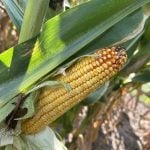Trade, dollar weigh on U.S. values
By Glen Hallick, MarketsFarm
Glacier FarmMedia MarketsFarm – Intercontinental Exchange canola futures closed lower on Friday, due to declines in comparable oil and the advancing Prairie harvest.
There was weakness in Chicago soybeans and soyoil while soymeal eased back. Losses in European rapeseed and Malaysian palm oil added more pressure on canola. Declines in crude oil weighed on vegetable oil values.
The overall Saskatchewan harvest passed the halfway point this week, with the province’s canola more than 21 per cent completed.
Read Also
ICE Canola Midday: Finding traction to the downside
By Glen Hallick Glacier FarmMedia | MarketsFarm – Canola futures on the Intercontinental Exchange were lower late Friday morning, after…
Dry weather was forecast for most of the Prairies this weekend, but there’s to be rain for parts of the eastern half of the region, including southern Manitoba.
The November canola contract fell further below its 20-day moving average, which added more pressure on canola prices.
The Canadian dollar was higher on Friday afternoon with the loonie at 72.62 U.S. cents, compared to Thursday’s close of 72.48.
There were 44,579 contracts traded on Friday, compared to 43,886 on Thursday. Spreading accounted for 28,258 contracts traded.
Prices are in Canadian dollars per metric tonne:
Price Change
Canola Nov 618.60 dn 5.30
Jan 631.50 dn 4.90
Mar 642.90 dn 4.70
May 652.80 dn 4.60
SOYBEAN futures at the Chicago Board of Trade were weaker on Friday, after the much anticipated phone between United States President Donald Trump and Chinese President Xi Jinping produced very little in terms of trade.
Trump and Xi are to talk face-to-face at the APEC meeting in South Korea next month, with Trump expected to visit China in 2026. China has been notably absent from the U.S. Department of Agriculture’s weekly export sales reports.
The USDA said Taiwan signed a deal to buy US$10 billion of agricultural goods from the U.S., including soybeans, corn and wheat. Over the last five years, Taiwan’s average purchases have been between US$3.2 billion and US$4.2 billion.
A report out of Australia said Western Australia is now expected to produce 3.30 million tonnes of canola in 2025/26, up 225,000 tonnes from a previous estimate and above the five-year average of 2.80 million.
CORN futures were narrowly mixed on Friday, with a quarter-cent gain in the heavily traded December contract, then small losses in the other positions.
The USDA announced a private sale for 206,460 tonnes of 2025/26 corn to unknown destinations.
Uncertainty surrounding U.S. biofuel policies pressured corn.
WHEAT futures were lower on Friday, due to strength in the U.S. dollar.
The U.S. Northern and Southern Plains along with the Midwest are to get scattered showers over the weekend, while an area including Illinois and Missouri are to see heavier rains.
Coceral estimated combined European Union and United Kingdom wheat crop at 147.40 million tonnes, up 4.3 million from the consultancy’s June estimate.
Western Australia was pegged to produce 11.80 million tonnes of wheat in 2025/26, up 300,000 tonnes from the previous estimate and more than the five-year average of 11.20 million.
South Korea bought 30,000 tonnes of U.S. milling wheat.









